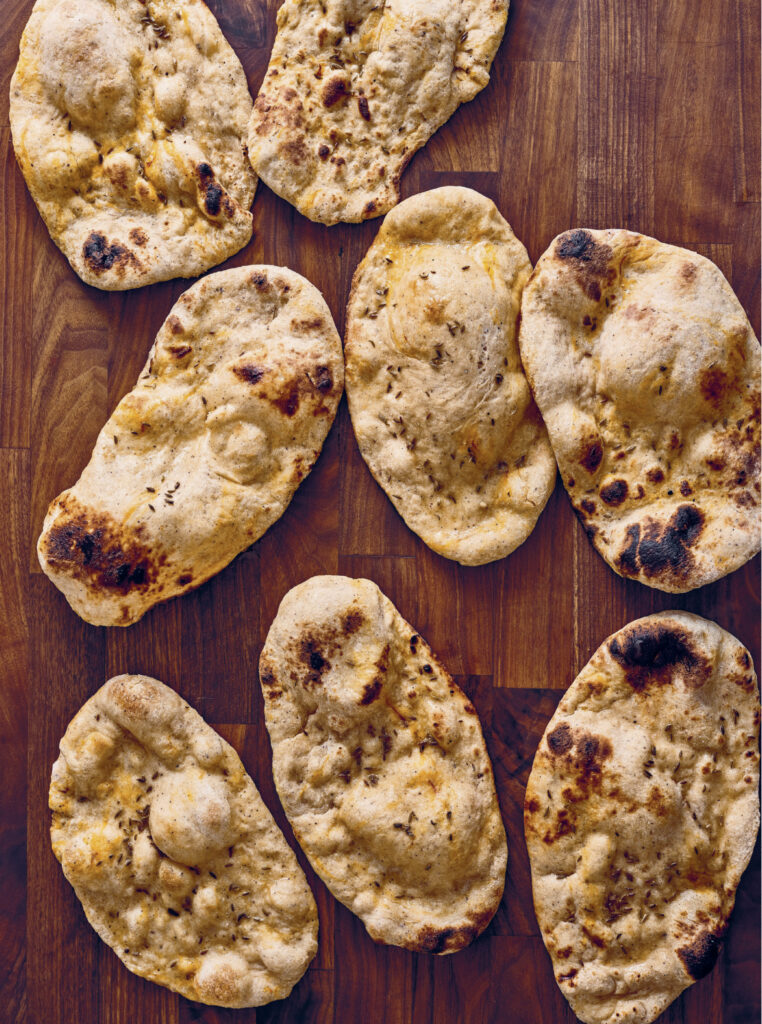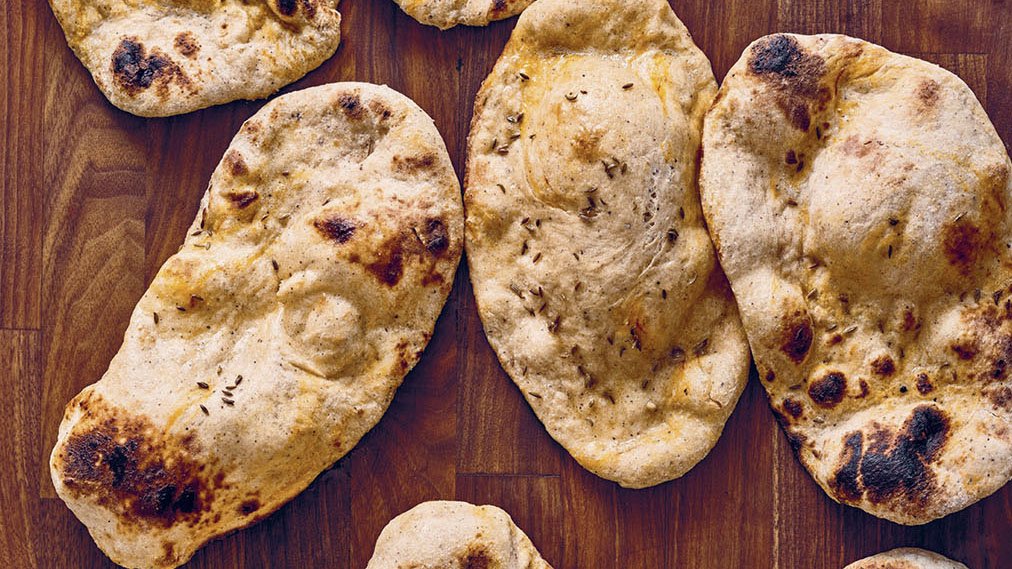 Originating in ancient Egypt and brought to India via the Persians, naan is the one of the most popular breads to rise out of the Mughal Empire in India. Created and sustained by military warfare and founded in the 1500s by Babur, the Mughal Empire ruled over northern parts of India for hundreds of years. In the wake of these Muslim invaders sweeping down the Khyber Pass, the cuisine of northern India went through a huge shift. The tandoor, a giant clay or concrete oven often built into the ground that could withstand temperatures of over 600°F, had arrived in India. Skewered kebabs and a variety of breads emerged from this new cuisine. Naan became the most popular of breads, and this version, in particular, harkens back to its royal heritage with the aroma of rose water, saffron, and vetiver. Used in desserts and certain curries, vetiver, aka khus, is a fragrant grass native to India. It is sold as an extract in Indian grocery stores and can be replaced with vanilla or almond extract. Naan dough can be made the day before, but give it 2 to 3 hours of proofing time at room temperature before baking.
Originating in ancient Egypt and brought to India via the Persians, naan is the one of the most popular breads to rise out of the Mughal Empire in India. Created and sustained by military warfare and founded in the 1500s by Babur, the Mughal Empire ruled over northern parts of India for hundreds of years. In the wake of these Muslim invaders sweeping down the Khyber Pass, the cuisine of northern India went through a huge shift. The tandoor, a giant clay or concrete oven often built into the ground that could withstand temperatures of over 600°F, had arrived in India. Skewered kebabs and a variety of breads emerged from this new cuisine. Naan became the most popular of breads, and this version, in particular, harkens back to its royal heritage with the aroma of rose water, saffron, and vetiver. Used in desserts and certain curries, vetiver, aka khus, is a fragrant grass native to India. It is sold as an extract in Indian grocery stores and can be replaced with vanilla or almond extract. Naan dough can be made the day before, but give it 2 to 3 hours of proofing time at room temperature before baking.

Royal Naan
Ingredients
- 1/4 teaspoon saffron strands
- 1-1/4 cups warm milk
- 1 teaspoon active dry yeast
- 1 tablespoon cane sugar
- 1 teaspoon khus, or 4 or 5 drops vetiver (optional)
- 1 teaspoon rose water
- 2 large eggs
- 3 cups all-purpose flour or bread flour
- 1 cup roti flour or whole-wheat pastry flour
- 2 tablespoons semolina flour
- 1 teaspoon ground green cardamom seeds
- 1 teaspoon freshly ground black pepper
- 2 teaspoons sea salt
- Olive oil for coating the dough
- Sesame seeds, fennel seeds, or cumin seeds for sprinkling
- Ghee for spreading
Instructions
- Soak the saffron in the hot milk for 30 minutes or overnight in the refrigerator.
- In a large bowl, whisk the warm saffron milk, yeast, sugar, khus (if desired), rose water, and eggs. Add the all-purpose flour, roti flour, semolina flour, cardamom seeds, black pepper, and salt and mix until a dough comes together into a ball that’s soft and slightly sticky. Coat the dough with olive oil. Lay a clean kitchen towel over the bowl and let the dough rise at room temperature for 2 to 3 hours, until it doubles in size. If not using immediately, refrigerate in the same bowl or a large storage container (as it will rise) until you’re ready to make the naans.
- Adjust an oven rack to the lower part of the oven and set a ceramic tile (see page 237), pizza stone, or inverted baking sheet in the center of the rack.
- Preheat the oven to as hot (at least 500°F) as it will get for at least 1 hour; preferably 2 hours.
- Divide the risen dough into ten equal balls, punching down slightly as you go. Cover the balls with a clean kitchen towel and let rest for 1 hour, or until they have doubled in size.
- Using a few drops of oil, use your fingers to press each ball into an oval about 7 inches long and about 4 inches wide. Or gently roll it out using a rolling pin. Sprinkle some seeds on top.
- Quickly lay four to six naans on the hot tile with 1 inch in between each. Immediately close the oven and bake the naans for 2 to 3 minutes. Open the oven and, using tongs, remove the naans. The bottom part will be golden in color, but if the top is not, quickly flame the naans over the burner of a gas stove. Smear ghee on the naans while hot. Repeat with the remaining dough.
- Naans, like most bread, are best eaten fresh, but if you need to make them ahead of time, let them cool on a wire rack in a single layer so they do not steam from the bottom. To reheat them, sprinkle a few drops of water on each, lay them directly on the oven racks in a preheated 450°F oven, over a grill, or directly over a gas flame, turning them with tongs and working quickly so as not to burn the edges. They can be left at room temperature for a day or frozen in an airtight plastic bag for up to 6 months.
Notes
 Reprinted with permission from Masala: Recipes from India, the Land of Spices by Anita Jaisinghani, copyright © 2022. Published by Ten Speed Press, an imprint of Penguin Random House. Photographs copyright © 2022 by Johnny Autry. Illustrations copyright © 2022 by Julie Keselman.
Reprinted with permission from Masala: Recipes from India, the Land of Spices by Anita Jaisinghani, copyright © 2022. Published by Ten Speed Press, an imprint of Penguin Random House. Photographs copyright © 2022 by Johnny Autry. Illustrations copyright © 2022 by Julie Keselman.

